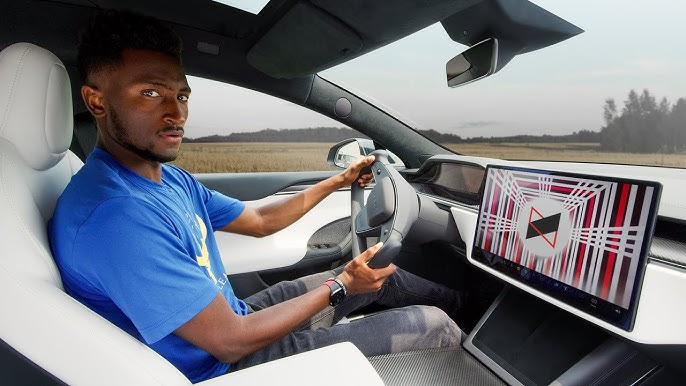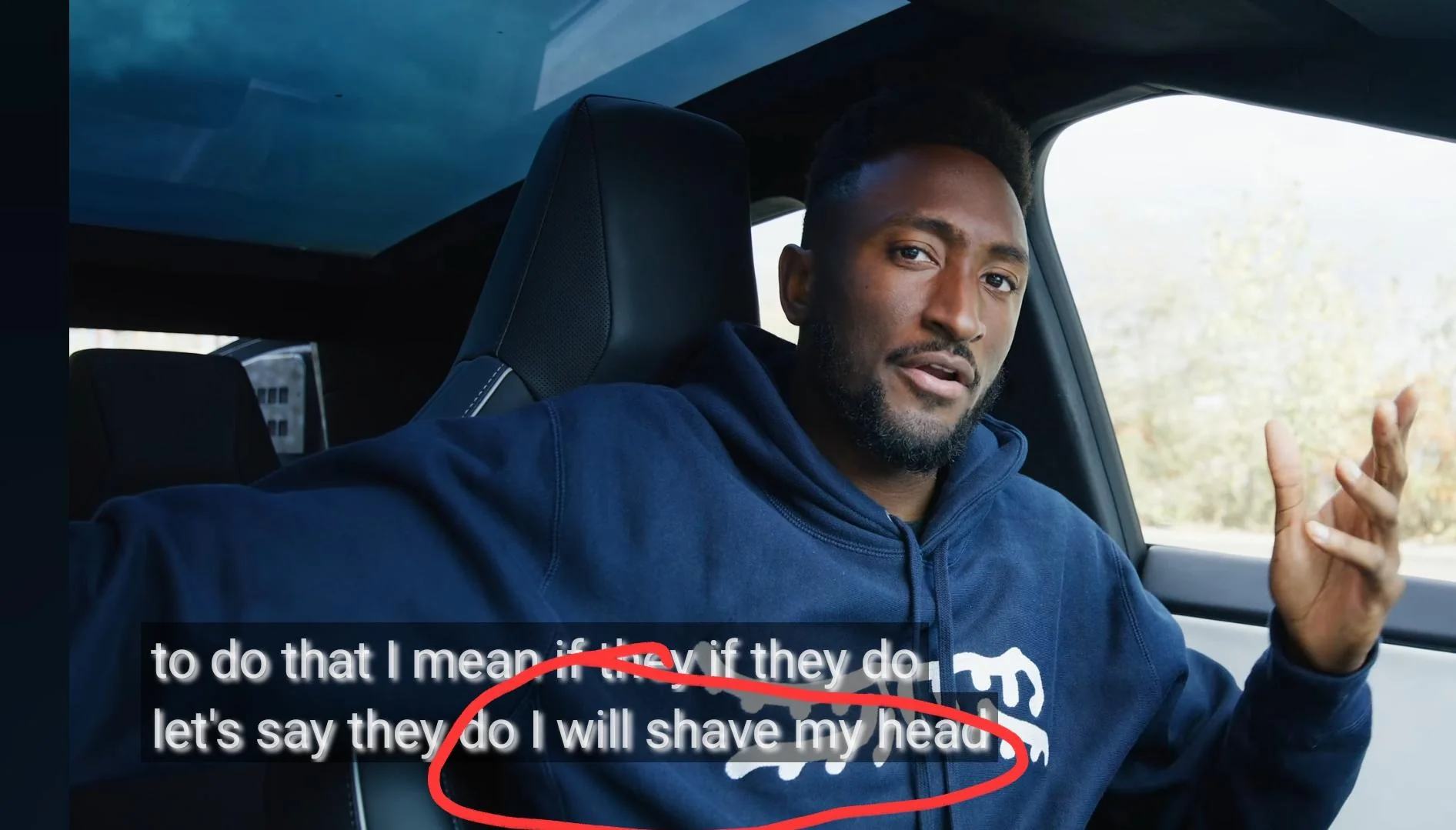In a bold and humorous take on Tesla’s ambitious plans for fully autonomous vehicles, popular tech YouTuber Marques Brownlee, better known as MKBHD, has raised some serious questions about the feasibility of Elon Musk’s timeline for Tesla’s much-anticipated Robotaxi.
Brownlee’s video review of Tesla’s Cybercab offers insight into his doubts, particularly regarding the vehicle’s release before 2027. He went as far as to promise to shave his head on camera if Tesla manages to meet its aggressive timeline.
MKBHD’s Skepticism: “No Way Tesla Delivers Before 2027”
Marques Brownlee is not just any tech reviewer; he’s one of the most influential voices in the technology and EV space. His insights and opinions carry significant weight in the tech world, and his recent video on Tesla’s Cybercab brought attention to several concerns that many industry experts have been grappling with for some time.
In his video, Brownlee provided a hands-on review of the Cybercab, highlighting some of its futuristic features. From the lounge-like seating to the 21-inch touchscreen and upward-opening doors, the Cybercab certainly presents a glimpse of what the future of autonomous vehicles could look like.
However, despite these innovative features, Brownlee remained highly doubtful about the car’s actual readiness and Tesla’s ability to meet its promises on time.
Read : Elon Musk Unveils Fully Autonomous Tesla Robotaxi Cybercab
A central point in Brownlee’s criticism is the timeline. Tesla has a history of ambitious deadlines that it often fails to meet, particularly when it comes to its self-driving technology.
Brownlee mentioned that Elon Musk tends to make grand statements about upcoming Tesla models or technological innovations, only for those projects to face multiple delays.
For instance, Tesla’s fully autonomous self-driving technology has been “just around the corner” for years, yet regulatory approval and other obstacles have continued to slow progress.
“I think the obvious red flag, the biggest red flag to me is the timeline stuff,” Brownlee stated. “There’s just no way that they’re actually going to be able to do that. I mean, if they do, let’s say they do—I will shave my head on camera because I’m that confident.”
It’s not just the timeline that concerns Brownlee; he also expressed doubts about the Cybercab’s pricing. Tesla has claimed that the fully autonomous Robotaxi would cost less than $30,000—a figure that Brownlee and many others in the industry find hard to believe given the current costs of self-driving technology and EV production.
Tesla’s History of Delayed Technology
Brownlee’s skepticism is rooted in Tesla’s track record of delayed projects and over-promised timelines. Musk has become notorious for announcing ambitious projects that often fall behind schedule. While Tesla has revolutionized the electric vehicle market, it has faced significant challenges in delivering some of its most highly anticipated features.
For example, Tesla’s “Full Self-Driving” (FSD) technology has been in development for years, with Musk repeatedly promising that it would be ready for general use.

Despite these assurances, FSD remains in beta testing, with significant hurdles to overcome before it can be deployed at scale. Regulatory approvals, technical complexities, and safety concerns have all contributed to the delays in rolling out fully autonomous driving features.
The Robotaxi concept is another bold idea from Musk, but it faces similar obstacles. While Tesla has made significant strides in electric vehicle technology and autonomous driving, creating a fully self-driving taxi service that is both affordable and regulatory-compliant by 2027 seems like an incredibly ambitious goal.
Tesla’s ability to meet that timeline is further complicated by the fact that no major automaker has yet successfully launched a widespread autonomous taxi service, despite years of development and investment.
Moreover, Tesla’s struggle to meet its pricing promises adds another layer of doubt. The company has been known to promise lower prices for its vehicles, only to later raise prices due to supply chain issues, production costs, or other market factors.
The idea that Tesla can deliver a fully autonomous Robotaxi for under $30,000 seems far-fetched, given the current costs of electric vehicle production and the additional expenses of self-driving technology.
Market Reactions: Analysts Share Brownlee’s Concerns
MKBHD’s doubts about Tesla’s Robotaxi timeline aren’t just shared by tech enthusiasts; they echo broader concerns among analysts and investors. While Tesla remains a leader in the EV market, its ambitious goals for autonomous driving have left many skeptical about whether the company can deliver on time.
Wedbush analyst Dan Ives expressed cautious optimism about Tesla’s autonomous vehicle trajectory but acknowledged that regulatory approvals and insurance complexities will be major obstacles.
Ives is generally bullish on Tesla’s innovation but recognizes that the company’s ability to meet its timeline for the Robotaxi will be contentious.

Gene Munster from Deepwater Asset Management offered a more critical view, expressing disappointment in the Cybercab’s projected timeline. For investors who are already skeptical of Tesla’s stock performance, the long wait for the Robotaxi launch may push them further away from investing in the company.
Tesla is also facing stiff competition in the autonomous vehicle market. Companies like Uber, Waymo, and others have been developing their own self-driving technology, and while none have successfully launched a large-scale autonomous taxi service, they are making progress.
Uber, in particular, is already a well-established player in the ride-hailing industry and could pose a significant threat to Tesla’s Robotaxi plans if it can integrate autonomous vehicles into its fleet before Tesla’s launch.
The Future of Autonomous Vehicles: Can Tesla Deliver?
The skepticism surrounding Tesla’s Robotaxi project reflects broader uncertainties about the future of autonomous vehicles. While self-driving technology has made significant strides in recent years, several obstacles remain before it can become mainstream.
One of the biggest challenges is regulatory approval. Fully autonomous vehicles need to be approved by government agencies to ensure they meet safety standards, and this process can be slow and complicated. In many regions, laws and regulations surrounding autonomous vehicles are still being developed, which could further delay the widespread adoption of self-driving cars.
Another challenge is the technological complexity of autonomous driving. While Tesla’s Autopilot and Full Self-Driving features are impressive, they are not yet capable of handling all driving scenarios. Edge cases—unusual or unexpected situations that occur on the road—remain a major hurdle for autonomous systems.
For Tesla to deliver a fully self-driving Robotaxi, it will need to solve these issues and prove that its system can safely navigate a wide range of driving environments.
Finally, there is the question of consumer trust. Many people remain wary of autonomous vehicles, particularly after high-profile incidents involving Tesla’s Autopilot system. For the Robotaxi service to be successful, Tesla will need to convince consumers that its vehicles are safe and reliable.

Despite these challenges, Tesla continues to push forward with its vision of autonomous transportation. The company has a track record of defying expectations and disrupting industries, so while the timeline may be overly ambitious, it is possible that Tesla could eventually deliver on its Robotaxi promises. Whether it happens before 2027, however, is a different story.
MKBHD’s playful challenge to Elon Musk underscores the broader skepticism surrounding Tesla’s Robotaxi timeline. While the idea of a fully autonomous, affordable taxi service is certainly appealing, there are numerous obstacles that Tesla must overcome before it can become a reality.
Brownlee’s doubts reflect a wider sentiment among industry experts and investors, many of whom believe that Tesla’s ambitious timeline is unrealistic. As the debate continues, one thing is clear: if Tesla does manage to launch its Robotaxi before 2027, MKBHD’s head will be the first to feel the impact.

